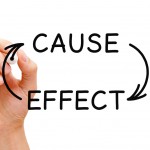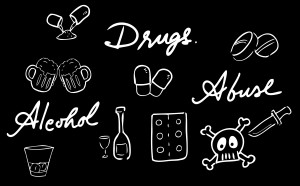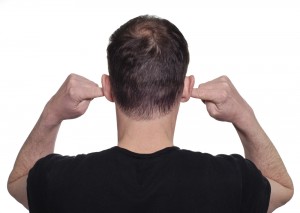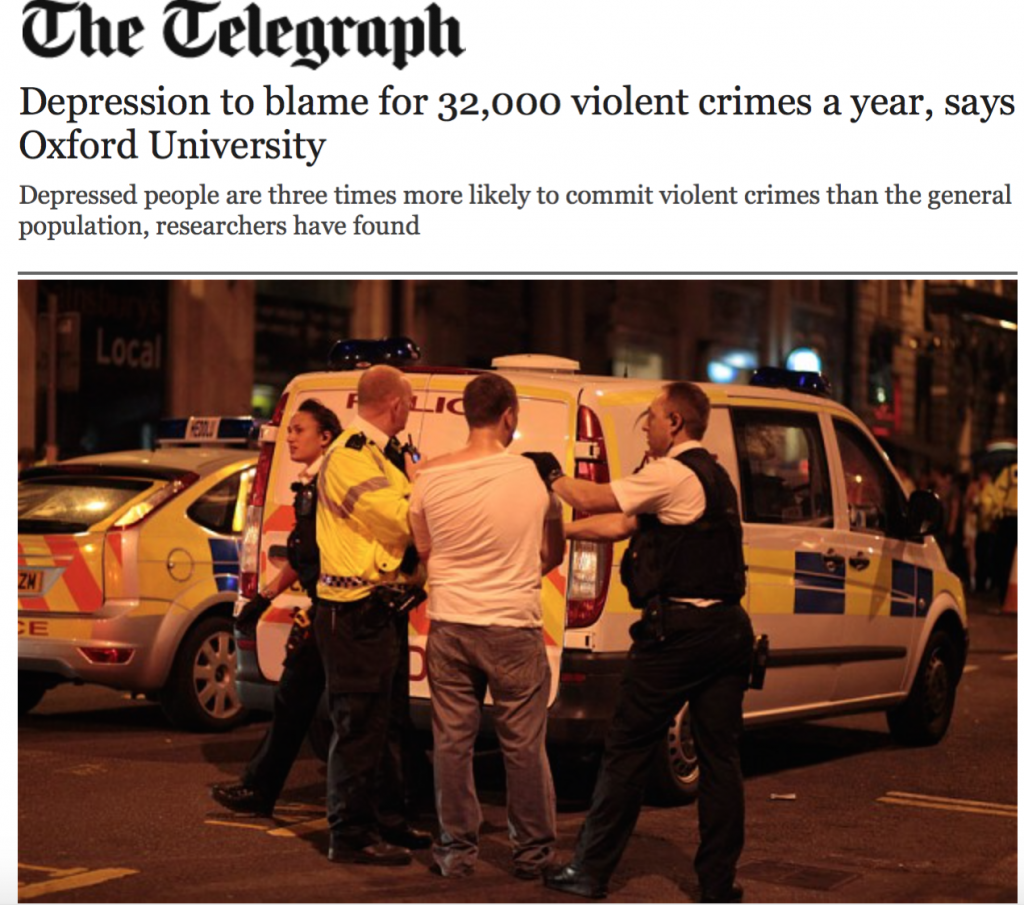
A team of researchers have used national registers from Sweden to show that 3.7% of men and 0.5% of women with depression were convicted of violent crime compared to 1.2% of men and 0.2% of women without depression.
Some headlines reporting on this research have been a little inflammatory to say the least. This is a headline from The Daily Telegraph article written by @sarahknapton, Science Editor: “Depression to blame for 32,000 violent crimes a year, says Oxford University.”
Research on mental health and violence is not new here in the woodland and neither are my frustrations with misleading headlines. So let’s get below the haze of misleading headlines and focus on the hard science.
To make a clear association between depression and violent crime, Fazel and colleagues at the University of Oxford Department of Psychiatry conducted two studies using data from Sweden. Apparently Sweden isn’t the utopia I imagined and they actually have similar levels of crime to the USA and Australia.
What is “Violent Crime”?
This was anyone on the Swedish national crime register convicted of one or more of the following:
- Homicide (completed or attempted)
- Common or aggravated assault
- Robbery
- Arson
- Any sexual offence
- Illegal threats or intimidation
“Register Study” methods
This involved 5 registers containing information on health, family, death and crime. Each person has a unique number that identifies and connects them across the registers (a little “Big Brother” but handy for population research).
The selection criteria produced 47,158 people with depression based on:
- Being born between 1958 and 1994
- Diagnosed with at least two episodes of depression between 2001 and 2009
- Have not had an inpatient admission or another psychiatric disorder
On average those with depression were followed up for 3 years.
Each of these people with depression was then compared to up 20 people who were of the same sex and a similar age from a sample of 898,454 non-depressed people.
They also looked at the rates of violent crime within a sample of 15,534 half-siblings and 33,516 full-siblings with depression and compared them with the general population.
“Twin Study” methods
A sample of 15,298 twin pairs born 1959 to 1986 was selected from those who had participated in a previous study. This sample included 5,574 pairs sharing 100% of their genetic information (monozygotic) and 9,724 sharing 50% of their genetic information (dizygotic).
Rates of depression amongst this sample was determined by their responses to questionnaire (the sCESD), which they filled out back in 2005.
Any criminal behaviour was then followed up via the Crime Register.

These ingeniously designed studies included sensitivity analyses that allowed the authors to adjust for a variety of confounders, including substance abuse comorbidity.
Results
The following rates of violent crime were reported:
| Total | % of men convicted of a violent crime | % of women convicted of a violent crime | |
| Depressed people | 47,158 | 3.7 | 0.5 |
| Non-depressed people | 898,454 | 1.2 | 0.2 |
Effect of depression on rate of violent crime
When the results were analysed the researchers removed the effects of low income, immigrant status, history of self-harm, criminal record, and drug and alcohol misuse. We’d expect these to play a role in violent crime so it was important to remove their effect.
After removing the above factors the researchers produced an odds ratio of 3.0 (with 95% confidence intervals of 2.8 to 3.3). This means that those with depression were three times more likely to have been convicted of violent crime than those without depression.
Three times?! It sounds a lot, but remember this is the relative risk (only 3.7% of men and 0.5% of women with depression were actually convicted of violent crime) and the absolute risk remains quite low for men and very low for women.
Effect of co-occurring risk factors on violent crime
The rate of violent crime amongst those with depression is dependent on other, related risk factors:
- The rate of violent crime amongst those with a history of substance abuse was 8.9% (for men) and 2.1% (for women) (compared to 3.7% and 0.5% for those without any history)
- The rates for those with a history of violent crime was 12.5% (men) and 3.8% (women)
- For self-harm the rate was 6.5% (men) and 1.4% (women)
- When there was a history of all three of these risk factors the rate of violent crime increased to 16.3% (men) and 9.5% (women)
This clearly shows that significant risks of violent crime are limited to a subtype of people with depression.

Study participants with depression and a history of violent crime, substance abuse or self-harm, were significantly more likely to commit violent crime during the 3-year follow-up.
Effects of family factors on violent crime
After controlling for demographic factors like family income, the likelihood of violent crime amongst siblings of those with depression was significantly higher than those in the general population:
- Amongst half siblings the odds ratio was 1.2 (95% confidence intervals 1.1 to 1.4)
- Amongst full siblings this was 1.5 (95% confidence intervals 1.3 to 1.6)
The authors suggested family connection may therefore play a role in the relationship between depression and violent crime, but the association goes beyond the early environmental and genetic factors shared by siblings.
Findings from the “Twin Study”
In the Twin Study there were 88 violent crimes in 5.4 years of follow-up. The researchers found that any crime was significantly associated with increased depressive symptoms. This was a hazard ratio of 1.09 (95% confidence intervals 1.06 to 1.13).
Conclusions
The authors concluded that:
The magnitude of the effects, certainly when compared with those for self-harm in the same population, suggest that assessment of the risk of violence should be considered routinely for some individuals with clinical depression and potentially included more consistently in clinical guidelines.

Should clinical guidelines recommend violence risk assessment in some groups of people with depression?
Interpreting the findings
The authors point out some limitations which mean we must be cautious about what we take from the findings:
- The twin study wasn’t big enough to tell as about the role of genetic factors relative to environmental factors
- These results concern only those seen by specialist services and not in primary care
- The data was from Sweden only
- There is no information about any treatments the study participants were receiving
Prof Joe Herber, Emeritus Professor of Neuroscience, University of Cambridge, points out several other limitations not included by the researchers:
- It is not clear if those with depression were recovered at the time they committed the crime or not. Is it a history or the current presence of depression that is related to violent crime?
- The average age of onset of depression of those studied was 30. This misses out those whose onset was during adolescence; something that can have an adverse effect on education and achievement which might predispose people towards anti-social behaviour.
- Other factors like substance abuse have a large effect on the risk of violent crime. Despite attempts to statistically separate these, perhaps there is a pattern amongst those convicted of violent crime, rather than a single factor like the diagnosis of depression.
- We are missing information about lifestyle factors. The advent of aversive life experiences often precede depression and may have their own contribution to the risk of violent crime.
I noticed that two of the authors declare financial links with major pharmaceutical companies. There’s nothing to suggest this biased their interpretations of the data but depression is a big market for pharmaceutical companies.

It’s worth noting that patients in this study had an outpatient diagnosis of depression in secondary or tertiary care.
Summary
Although this study seems reliable and valid, we have to be clear that it is only an association and doesn’t prove that depression causes people to commit crimes. This difference doesn’t seem to be something that is appreciated or grasped by the media and audiences.
From looking at the headlines from this study, we can see how easily the media spin a press release to make a headline that captures attention but reinforces stigma.
I felt uncomfortable with the conclusions of this study (i.e. focusing on the need to routinely risk assess for violence in some subgroups of patients with depression) which seem to collude with the idea that those with mental health problems are the perpetrators rather than victims of social problems.
Finally, it’s worth putting the findings of this research in context with the results of other studies. Seena Fazel has been doing excellent work in this field for a number of years (Fazel et al, 2014; 2010; 2011) and so we can compare the adjusted odds ratios for violent crime in patients versus the general population for a number of mental health conditions (all statistically significant findings):
| Condition | Adjusted odds ratio for violent crime in patients vs general population |
| Schizophrenia | 7.4 |
| Bipolar | 5.8 |
| Traumatic brain injury | 3.3 |
| Depression | 3.0 |
| Epilepsy | 1.5 |

We can’t ignore the research that shows mental health service users are at increased risk of committing violent crime, even if this evidence does not fit comfortably with anti-stigma messages.
Links
Primary study
Fazel S, Wolf A, Chang Z, Larsson H, Goodwin GM, Lichtenstein P. (2015) Depression and violence: a Swedish population study. The Lancet Psychiatry, Volume 2, Issue 3, March 2015, Pages 224-232, ISSN 2215-0366.
Other references
Fazel S, Wolf A, Palm C, Lichtenstein P. (2014) Violent crime, suicide, and premature mortality in patients with schizophrenia and related disorders: a 38-year total population study in Sweden. Lancet Psychiatry 2014;
1: 44–54.
Fazel S, Lichtenstein P, Grann M, Goodwin GM, Långström N. (2010) Bipolar disorder and violent crime: new evidence from population-based longitudinal studies and systematic review. Arch Gen Psychiatry 2010 Sep;67(9):931-8. doi: 10.1001/archgenpsychiatry.2010.97.
Fazel S, Lichtenstein P, Grann M, Långström N. (2011) Risk of violent crime in individuals with epilepsy and traumatic brain injury: a 35-year Swedish population study. PLoS Med 2011; 8: e1001150.


RT @Mental_Elf: Depression to blame for violent crime? The curse of the headline writers http://t.co/jhKJ6kFOTt
Stigmatising headlines, misreporting about violent crime and #mentalhealth http://t.co/zv0UPc4vRA
Läs detta noggrant! RT “@Mental_Elf: Depression to blame for violent crime? The curse of the headline writers http://t.co/TcIiHzYqXa”
The major flaw in this study that it doesn’t differentiate between a diagnosis of depression and the medication prescribed for it.
Today @LaurenceDCP highlights study by @seenafazel, which investigates links between depression & violent crime http://t.co/jhKJ6kFOTt
@Mental_Elf I hope it does work http://t.co/wSQ3oabTXe
@Mental_Elf @LaurenceDCP 1. In fact, media reporting on the paper was quite balanced – see @NHSChoices summary: http://t.co/hy4iBVt9ju
@Mental_Elf @LaurenceDCP 2. Widely reported media were v balanced. Reuters picked up by Mail online and elsewhere: http://t.co/nfsW10Sp9Y
@Mental_Elf @LaurenceDCP 3. Guardian report subtitle is another case in point as it highlights low absolute rates: http://t.co/zY9rLFEy5o
@Mental_Elf @LaurenceDCP 4. Couple of limitations need commenting. First, we looked at timing of depression in relation to violent crime.
@Mental_Elf @LaurenceDCP 5. The comment on other factors does not account for the designs used via unaffected sibling controls and twins
Andy Conway liked this on Facebook.
The Mental Elf liked this on Facebook.
@sarahknapton Depression to blame for violent crime? http://t.co/jhKJ6kFOTt
“Depression to blame for violent crime?” @LaurenceDCP advises caution in interpreting links as causes on @Mental_Elf http://t.co/1StBxlKtFm
We’ve summarised @TheLancetPsych population study on #depression and #violence http://t.co/jhKJ6kFOTt
. @Mental_Elf See also tweets of clarification by @seenafazel.
@Mental_Elf @TheLancetPsych 1. when same direction of effect is found if compare cases w pop controls, unaffected sibs, discordant twins
@Mental_Elf @TheLancetPsych 2. And it is consistent with previous research e.g. MacArthur study, suggests some evidence of a causal link
Depression to blame for violent crime? The curse of the headline writers http://t.co/m3f0h1sAdi via @sharethis
Mental Elf: Depression to blame for violent crime? The curse of the headline writers http://t.co/gxVPKwRA9t
Don’t miss: Depression to blame for violent crime? http://t.co/jhKJ6kFOTt #EBP
Depression to blame for violent crime? http://t.co/tI26jd1aAa
[…] Depression to blame for violent crime? The curse of the headline writers (The Mental Elf, March 20, 2015) […]